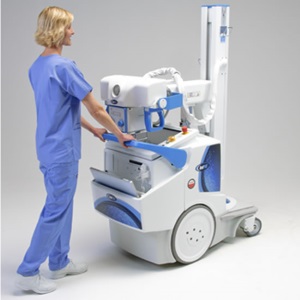August, 2014
- How electronic transactions could save healthcare $8B
- What Will The Hospital Room Look Like in The Future?
- Walgreen execs step down following billion-dollar Medicare business projection mistake
- Here are the basics on Canon’s product line
- GE Healthcare Selects RTI Connext DDS for Connectivity of Large Medical Instruments
The Internet of Things (IoT) is going to be connecting billions of ordinary things and making each one accessible through the Internet. This will revolutionize the way virtually everything functions by providing valuable insight to consumers, manufacturers, and service providers. One of the industries already taking advantage of this technology by deploying connected devices is healthcare. The potential for improving the delivery of care, lowering costs, and introducing new remote medical services presents one of the biggest opportunities for medical device manufacturers and healthcare providers. As one of the top medical device manufacturers in the world, GE Healthcare has made the decision to use the RTI Connext Platform to help it communicate more effectively with connected devices in hospitals.
- Was the feds’ $26B investment in health IT worth it?
- Hospitals Reconsider Charity For Patients Who Decline Health Coverage
“applicants who refuse to purchase federally-mandated health insurance when they are eligible to do so will not be awarded charitable care.”
- Prime finalizes purchase of St. Mary’s Hospital
Prime has agreed to invest more than $80 million into the hospital, including $30 million for capital improvements. Additionally, Prime will maintain St. Mary's as a 269-bed acute-care facility, maintain charity care levels, hire all existing employees and retain the hospital's physician base.
- Nonprofit hospitals at a tipping point from mounting challenges
One of ACA's unspoken or should I say a hidden goal is the reduction of the number of US hospitals. One of ACA’s chief architects, Ezekiel Emanuel, admits as much in his book “Reinventing American Health Care: How the Affordable Care Act will Improve our Terribly Complex, Blatantly Unjust, Outrageously Expensive, Grossly Inefficient, Error Prone System.” This Reuter’s article indicates that hospitals are at a tipping point and soon your local hospital may become just another vacant building in your home town.
- Why ‘Repeal and Replace’ Will Never Work
- Good luck – calls for repeal of the Medical Device tax over IRS screw up
This tax isn't going away. The gaping black hole of endless consumption, otherwise known as the Federal budget, knows no give back.
- China protects its manufacturers – why don’t we do the same?
The Chinese government as announced that going forward they would pursue policies explicitly designed to favor domestic manufacturers over foreign manufacturers.
- 100 things to know about Medicare reimbursement
- Seriously? Hospitals are paying ACA premiums in order to boost revenue
- VERY bad news for surgical sales reps: devicemaker sales reps being replaced in the OR
The rep-less model is being driven by pressures on hospitals to lower costs—declining reimbursement rates, lower patient volumes, financial risk arrangements with insurers, and employers and consumers seeking lower-cost procedures. The hospitals most likely to employ this model are academic medical centers, which have some of the most stringent policies on sales reps' access to clinicians and operating rooms. Some hospital officials say they favor the rep-less model because they are tired of paying “selling, general and administrative,” or SG&A, costs as part of the price of an implantable device. Those costs can make up nearly 40% of the price. Another reason is that they believe sales reps have become too heavily involved in clinical procedures.
- Info exchanges, electronic records: What do physicians want?
- Tax Inversion 101 for Medical Device Companies
- Healthcare providers are increasingly becoming technology innovators and venders themselves
- Did Medtronic Really Need To Worry About Tax Inversion Legislation And Hire Lobbyists?
- Health Care Price Growth Moderates
Health sector economic indicators that we need to be aware of. For example: drug prices are up while hospital charges are down. Good news if you're in the pharm business; not good news if you sell high dollar capital equipment to hospitals. Since the recession in 2007 Healthcare costs are up 14.5% while the economy as a whole deflated 10.5%. That means healthcare spending will be forced to constrict. This and many other useful facts are in this whitepaper.
- The Radiologist’s demise?
- 5 great mistakes in healthcare and how to fix them
A very thoughtful overview of why the Healthcare system isn't working and ACA wasn't the reform needed.
- PPACA medical device tax falls short of expected revenue
- Training users on technology is a significant business opportunity
- Cleveland Clinic sees lower margin and volume, higher expenses
A major champion of ACA doesn't seem to be doing so well.
- The extreme pessimist’s argument for population health
- The future of employee based health insurance is, wait for it…high deductable plans
- National Health Expenditure Data NHE Fact Sheet
- Only 10% of Medicaid Enrollees’ ED Use Is Unnecessary
Here is government thinking for you: they start the article with ONLY. Only 10% of ED visits under Medicaid are unnecessary. As ED visits account for 4% of the Medicaid's total spend the wasted money is in the BILLIONS, that's billions, with a b. In 2012 the spend according to the Kaiser Family Foundation on Medicaid was $415,154,234,831. Four percent of that is over $16 Billion dollars, ONLY 10% of which is wasted. As they say in Washington, a billion here and a billion there and soon you're talking about real money.
- Small Primary Care Physician Practices Have Low Rates Of Preventable Hospital Admissions
This article points out that the consolidation of physician practices has not demonstrated either cost savings or better clinical outcomes despite conventional wisdom. As independent physicians disappear private practice has become an endangered species. Nearly two-thirds of US office-based physicians work in practices of fewer than seven physicians. It is often assumed that larger practices provide better care, although there is little evidence for or against this assumption. What is the relationship between practice size—and other practice characteristics, such as ownership or use of medical home processes—and the quality of care?




